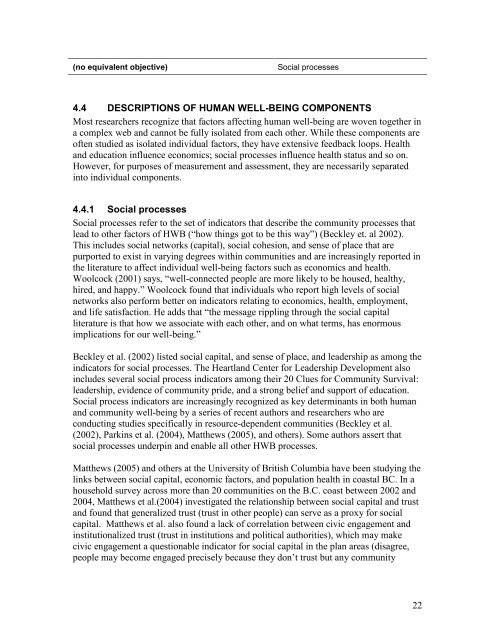Final report - Integrated Land Management Bureau
Final report - Integrated Land Management Bureau
Final report - Integrated Land Management Bureau
You also want an ePaper? Increase the reach of your titles
YUMPU automatically turns print PDFs into web optimized ePapers that Google loves.
(no equivalent objective) Social processes<br />
4.4 DESCRIPTIONS OF HUMAN WELL-BEING COMPONENTS<br />
Most researchers recognize that factors affecting human well-being are woven together in<br />
a complex web and cannot be fully isolated from each other. While these components are<br />
often studied as isolated individual factors, they have extensive feedback loops. Health<br />
and education influence economics; social processes influence health status and so on.<br />
However, for purposes of measurement and assessment, they are necessarily separated<br />
into individual components.<br />
4.4.1 Social processes<br />
Social processes refer to the set of indicators that describe the community processes that<br />
lead to other factors of HWB (“how things got to be this way”) (Beckley et. al 2002).<br />
This includes social networks (capital), social cohesion, and sense of place that are<br />
purported to exist in varying degrees within communities and are increasingly <strong>report</strong>ed in<br />
the literature to affect individual well-being factors such as economics and health.<br />
Woolcock (2001) says, “well-connected people are more likely to be housed, healthy,<br />
hired, and happy.” Woolcock found that individuals who <strong>report</strong> high levels of social<br />
networks also perform better on indicators relating to economics, health, employment,<br />
and life satisfaction. He adds that “the message rippling through the social capital<br />
literature is that how we associate with each other, and on what terms, has enormous<br />
implications for our well-being.”<br />
Beckley et al. (2002) listed social capital, and sense of place, and leadership as among the<br />
indicators for social processes. The Heartland Center for Leadership Development also<br />
includes several social process indicators among their 20 Clues for Community Survival:<br />
leadership, evidence of community pride, and a strong belief and support of education.<br />
Social process indicators are increasingly recognized as key determinants in both human<br />
and community well-being by a series of recent authors and researchers who are<br />
conducting studies specifically in resource-dependent communities (Beckley et al.<br />
(2002), Parkins et al. (2004), Matthews (2005), and others). Some authors assert that<br />
social processes underpin and enable all other HWB processes.<br />
Matthews (2005) and others at the University of British Columbia have been studying the<br />
links between social capital, economic factors, and population health in coastal BC. In a<br />
household survey across more than 20 communities on the B.C. coast between 2002 and<br />
2004, Matthews et al.(2004) investigated the relationship between social capital and trust<br />
and found that generalized trust (trust in other people) can serve as a proxy for social<br />
capital. Matthews et al. also found a lack of correlation between civic engagement and<br />
institutionalized trust (trust in institutions and political authorities), which may make<br />
civic engagement a questionable indicator for social capital in the plan areas (disagree,<br />
people may become engaged precisely because they don’t trust but any community<br />
22
















